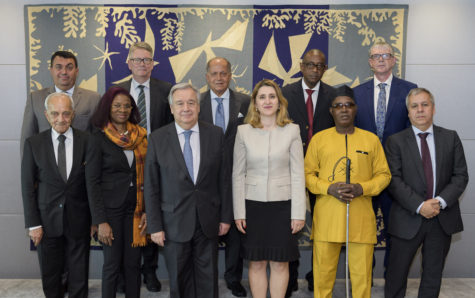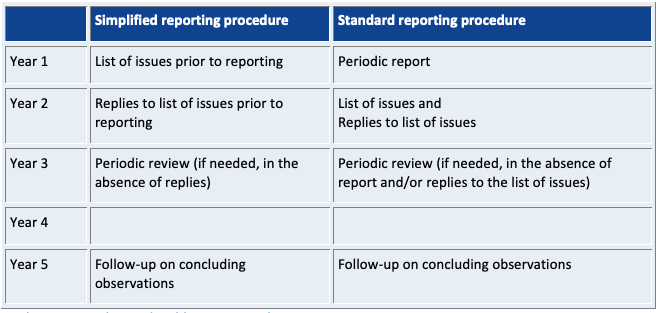
Credit: Manuel Elias via UN Photo
The United Nations Human Rights Committee has announced changes that will generally reduce the frequency and comprehensiveness of its review of States parties’ implementation of the International Covenant on Civil and Political Rights (ICCPR). With its first Predictable Review Cycle, the Committee will review all 173 States parties to the ICCPR between 2020 and 2027. See OHCHR, The Predictable Review Cycle. The changes mean that each State party will be reviewed every eight years (instead of approximately every five years), the cycle will begin with a list of issues prepared by the Committee for the State to address (unless the State opts to submit a comprehensive report first), and each State will be reviewed even if the State does not participate. These are the latest developments in the Committee’s ongoing efforts to implement the UN General Assembly Resolution 68/268 on “Strengthening and enhancing the effective functioning of the human rights treaty body system” and, more specifically, the Committee’s Decision on the Human Rights Committee on additional measures to simplify the reporting procedure and increase predictability. See id. The changes are also a response to challenges facing the Committee, including limited resources, a growing backlog of State reports, and lack of State compliance with recommendations and reporting deadlines. States that wish to opt-out of simplified reporting must notify the Committee’s Secretariat by December 31, 2019. See id.
Predictable Review Cycle
The Human Rights Committee’s 127th Session, taking place from October 14 to November 8, 2019 in Geneva, Switzerland, will be the last session the Committee holds before it implements the Predictable Review Cycle in 2020. The Committee has already published the Predictable Review Calendar for the 2020-2027 cycle with the aim of “improv[ing] predictability in reporting” and ensuring that all States parties regularly submit reports to the Committee. See OHCHR, Decision on the Human Rights Committee on additional measures to simplify the reporting procedure and increase predictability, July 2019. The Predictable Review Cycle will allow for all State reviews to continue as required, with or without State reports, facilitating oversight in spite of States’ non-cooperation. See id.
The Predictable Review Cycle consists of a full eight-year cycle, which includes a five-year review process that varies depending on whether States are operating under the simplified or “standard” reporting procedures, and a three-year interval period between review processes. See id. The Human Rights Committee will divide all States parties into eight groups of 21 or 22, and start their review process on a different reporting year. See id. The States scheduled for review in 2020 are listed in the Predictable Review Calendar. See id.
The following chart shows the various phases of the reporting process for States adhering to the simplified reporting procedure or maintaining the standard reporting procedure:

Simplified & Standard Reporting Procedures
Through its simplified reporting procedure, the Human Rights Committee invites States to respond only to questions (list of issues) prepared by the Committee prior to a State submitting a report. See OHCHR, Simplified reporting procedure: possible elements of a common aligned procedure, UN Doc. HRI/MC/2019/3, 15 April 2019, para. 3. This is an alternative to the standard reporting process, which requires a State to submit a comprehensive report that is not informed by what the Committee actually needs from the State, and also submit responses to subsequent list of issues. See id. In this way, States do not have to report on every topic covered by the ICCPR, but can focus only those issues that the Committee has raised as part of the review.
The simplified reporting procedure is intended to reduce the Committee’s workload and make it easier for States to meet their reporting obligations. See id. at para. 5. In In an effort to make this process more efficient, the Committee has also decided to limit its list of issues to 25 questions for each State. See OHCHR, Decision on the Human Rights Committee on additional measures to simplify the reporting procedure and increase predictability, July 2019.
Background
The Human Rights Committee’s efforts are part of a broader process to improve and reform the work of human rights treaty bodies, and implement the UN General Assembly Resolution 68/268. See OHCHR, Annual Meeting of Chairpersons of Human Rights Treaty Bodies. In 2014, the UN General Assembly adopted Resolution 68/268 on “Strengthening and enhancing the effective functioning of the human rights treaty body system,” underscoring the need to offer and facilitate the use of the simplified reporting procedure, work toward the alignment of methodologies among the treaty bodies, improve time efficiency, and incorporate a variety of measures that allow for better regional service. See UN General Assembly, Strengthening and enhancing the effective functioning of the human rights treaty body system, A/RES/68/268, 21 April 2014, paras. 1-2, 5, 17. The Resolution also established a funding scheme to better allow the treaty bodies to complete their work, and included a number of recommendations aimed at improving the treaty bodies’ transparency through the implementation of clear and accessible election policies. See id. at paras. 9-13, 27-28.
Moreover, the Committee’s changes build on the UN Treaty Body Chairpersons Position Paper on the future of the human rights treaty body system, which was adopted during the treaty bodies’ 31st annual meeting in July 2019, and proposes changes that include coordinated efforts among treaty bodies to avoid duplicative work and overlap of State reviews, among others. See IJRC, UN Treaty Bodies Announce New Measures to Synchronize their Work.
The original review procedure required States parties to submit an initial report within one year of ratification, and subsequent periodic reports every five years thereafter. See, e.g., OHCHR, Civil & Political Rights: The Human Rights Committee – Fact Sheet No. 15 (Rev. 1), p. 15. To build in flexibility, in 1997 the Committee decided to set individualized deadlines for States’ subsequent periodic reports, although it generally scheduled them approximately four to five years apart. See id. Originally, every review cycle began with the State’s submission of a report, which the Committee responded to with specific questions (list of issues). See id.
Additional Information
For more information on the UN Human Rights Committee, the Position Paper on the human rights treaty body system, and the UN human rights system, visit IJRC’s Online Resource Hub. To stay up-to-date on international human rights law news, visit IJRC’s News Room and subscribe to the IJRC Daily.
